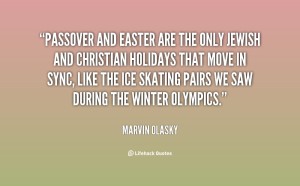
It’s the story of a people oppressed and enslaved. It’s the story of a baby boy rescued from death in order to one day be their deliverer. It’s the story of God speaking – through a burning bush, 10 plagues, blood on doorposts, parting a sea, and showering down bread from heaven. It’s a thrilling story that begs to be re-told time and time again.
Thirteen years ago, I celebrated my first Passover Seder in Jerusalem, Israel. This was a great way to break me into the practice since every Seder ends with this declaration: “Next year in Jerusalem.”
It wasn’t until the following year, however, when I celebrated Passover at the home of Jeff and Pat Feinberg in Chicago, that I was greatly enriched by this experience. My husband and I were in our first year of marriage and appeared in their Torah study one Friday night, never to miss a week after that.
Remembering the Exodus

That Passover, I learned how God’s people have been commanded to yearly retell the story of how God miraculously delivered their ancestors from slavery in Egypt through a historical event called The Exodus.
Every year, the Jews take the Seder plate (“Seder” means “order” – so it’s a dinner with a specific order) and experience once again the elements of their past. They remember the bitterness of slavery and oppression as they taste bitter herbs dipped in salt water, representing the tears of their ancestors.
They eat charoset, a mixture of apples, walnuts, honey, and wine between matza, which reminds them of the mortar, the cement that holds bricks together, that their people were forced to create.
The matza is unleavened bread – bread made in haste as they quickly fled Egypt.
There is the lamb shank bone which represents the Pesach (Passover) sacrifice.
The Jewish people retell this story every year for one main purpose: So that they don’t forget what their people have endured and how God delivered them miraculously in this time.
Christ, the Passover Lamb
The Exodus tells the story of a people and their God – Yahweh – the God that Christians worship, too. Through this story, we witness how He is a God who hears the cries of His people, how He miraculously delivered and provided for them each step of their journey with Him.
When Jesus celebrated The Last Supper with His disciples, He was celebrating Passover. In fact, Jesus said, “I have earnestly desired to eat this Passover with you before I suffer” (Luke 22:15).
As Christians, we believe that Christ left that last meal with His disciples and then went out and fulfilled Passover. As 1 Corinthians 5:7 says, “Get rid of the old yeast, so that you may be a new unleavened batch–as you really are. For Christ, our Passover lamb, has been sacrificed.”

Remembering Our Deliverance
When I celebrate Passover, I celebrate the God who shed His blood to deliver me from the bondage of my sin. His blood, wiped over the doorposts of my soul, has broken my shackles and set me free to journey with Him – out of slavery and into new life as a daughter of the Most High God.
When I taste the bitter herbs each year, I am reminded both of the Jews suffering in and liberation from Egypt and my own deliverance from a life of separation from God.
I celebrate that I no longer have to live a life of striving in my own works or effort to earn salvation. I rest in the completed work of Christ and take comfort that the God who parted the Red Sea is still alive and well and “will rescue me from every evil deed and bring me safely into his heavenly kingdom. To him be the glory forever and ever. Amen” (2 Timothy 4:18).
This April will mark 10 years that Joel and I have hosted Passover Seders in our home. We pack our home to the brim with friends old and new – to retell this story and to share our own.
It’s really quite simple – we keep telling the story so we won’t forget it. Next year in Jerusalem!


Please note: I reserve the right to delete comments that are offensive or off-topic.